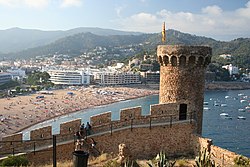Tossa de Mar
| Tossa de Mar | |||
|---|---|---|---|
| Municipality | |||
 |
|||
|
|||
| Location in Catalonia | |||
| Coordinates: 41°43′14″N 2°55′56″E / 41.72056°N 2.93222°E | |||
| Country |
|
||
| Community |
|
||
| Province | Girona | ||
| Comarca | La Selva | ||
| Government | |||
| • Mayor | Gisela Saladich Parés (2015) (Ind.) | ||
| Area | |||
| • Total | 38.6 km2 (14.9 sq mi) | ||
| Elevation | 6 m (20 ft) | ||
| Population (2014) | |||
| • Total | 5,681 | ||
| • Density | 150/km2 (380/sq mi) | ||
| Demonym(s) | Tossenc | ||
| Website | www |
||
Tossa de Mar (Catalan pronunciation: [ˈtosə ðə ˈmar]) is a municipality in Catalonia, Spain, located on the Costa Brava, about 103 kilometres north of Barcelona and 100 kilometres south of the French border. It is accessible through Girona Airport, some distance north.
There is ample evidence of settlements dating back to the Neolithic period, and it is believed that the area has been continuously populated since that time. Between the 4th-1st century BC the first Iberian settlements appeared, followed shortly after by the Romans in the 1st century.
In 966 Tossa was ceded by Count Miró of Barcelona to the Abbey of Ripoll. Some two centuries later, in 1187 Tossa was granted its charter by the Abbot of Ripoll, coinciding with the building of a church atop Mount Guardí, the remnants of which can still be seen today.
Sometime in the 12th century the mediaeval town was walled off and a castle was built on the highest point of Mt. Guardí, this castle was to be subsequently replaced by a wind mill, and this in turn by a lighthouse which is still operational.
By the year 1500 the first houses were built extra-murs to accommodate population growth. This process was greatly accelerated during the 17th and 18th centuries, shaping an urban configuration which was to remain practically unchanged until the arrival of mass tourism in the 1950s.
In 1989 Tossa de Mar was the first place in the world to declare itself an Anti-Bullfighting City.
Contrary to popular belief that Tossa has traditionally been a fishing town, in medieval times and until the arrival of tourism, the local economy was mostly based on agricultural production, principally Grape vine and cork. There was a thriving export market of the latter (in the form of cork taps shipped to the Americas) during the 18th century and early 19th century.
...
Wikipedia




